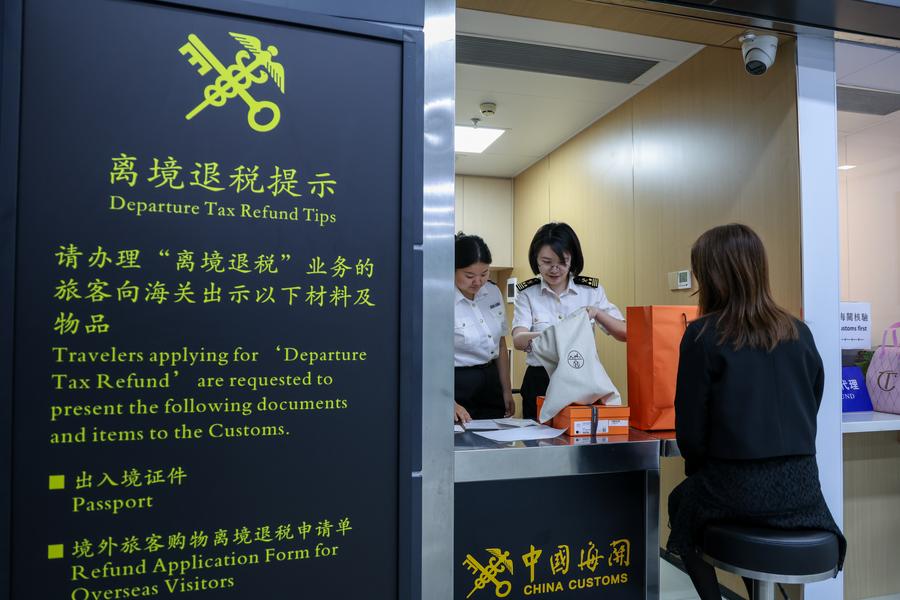China will select 15 pilot cities this year to receive targeted central government funding for their efforts to optimize the consumption environment, according to a recent policy notice issued by the Ministry of Finance and the Ministry of Commerce.
The existing international consumption center cities — Shanghai, Beijing, Guangzhou, Tianjin and Chongqing — will be a major focus of support. The five cities already play a major role in driving consumption, boast strong growth potential, and attract large numbers of international visitors.
In 2024, spending by international travelers in China accounted for approximately 0.5 percent of the country's GDP, compared with between 1 percent and 3 percent in major economies. This shows that inbound consumption still has enormous room to grow in China.

Customs officers check "refund-upon-purchase" goods at Wenjindu port in Shenzhen, south China's Guangdong Province, April 30, 2025. (Xinhua/Mao Siqian)
According to data from the Ministry of Commerce, as of July this year, the five international consumption center cities together accounted for more than one-eighth of China's total retail sales of consumer goods. They hosted one-quarter of all national demonstration pedestrian streets, about one-third of China's time-honored brands, over half of the country's total consumer goods imports, and roughly 70 percent of sales achieved under the departure tax refund policy.
Beyond the five cities, officials will also select other cities with strong consumer appeal, growth potential and significant foreign visitor numbers. Each of the five international consumption center cities will receive 200 million yuan ($28.1 million) in central government funding, while other selected cities will receive 100 million yuan each.
To further enrich the supply of high-quality goods and services for consumption, the notice calls for the development of a reasonable number of shopping hubs, shopping districts, and landmark projects.
To optimize international payment services, measures will be implemented to expand point-of-sale (POS) payment coverage in key venues, establish additional foreign currency exchange outlets, and encourage merchants to maintain sufficient cash reserves.
Other efforts include enhancing multilingual services, providing convenient amenities such as luggage storage, setting up information desks for international tourists, offering volunteer services in multiple languages, and more.
Many international tourists still depend on cash or credit cards, which can be inconvenient in China, where mobile payments have become mainstream. Enhancing payment options for foreign visitors is crucial to nurturing an internationalized consumption environment.
Two key indicators will be used to assess the pilot program's performance: the number of new POS terminals that accept foreign bank cards and the number of new foreign currency exchange outlets.
Amid the surge in inbound tourism, an increasing number of international tourists are visiting the Three Gorges Dam on the Yangtze River in Yichang, central China's Hubei Province. From January to August this year, the city welcomed 290,000 international visitors and earned 900 million yuan in tourism revenue, up 33 percent and 35 percent year on year, respectively.
To make travel and consumption easier, Yichang has rolled out several measures. More than 70 multilingual signs have been installed along major roads, and over 260 POS terminals accepting foreign bank cards are now in place citywide.
Beyond upgrading infrastructure, efforts are also underway to enhance the "soft environment." Authorities are leveraging themes such as intellectual property, the digital economy, green development, smart technology and Guochao, a trend that blends modern design with traditional Chinese culture. These themes are shaping rich and integrated consumption experiences. Improved policies and infrastructure make shopping more convenient and comfortable. Training programs also help staff expand their skills and improve service.
Expanding the number of stores that offer tax refunds for foreign visitors in China enhances access to high-quality goods and services. In April this year, the country introduced a package of measures to further optimize the departure tax refund policy. Since then, the number of tax refund stores catering to foreign visitors has surpassed 1,400 in both Beijing and Shanghai and exceeded 500 in Guangzhou, boosting sales under the departure tax refund policy by 94.6 percent in the first half of the year.
Over the past four years, the five international consumption center cities have introduced 12,000 first stores for both Chinese and international brands, drawing numerous global brands to open their first stores, debut new products and host inaugural exhibitions.
(Source: People's Daily)
